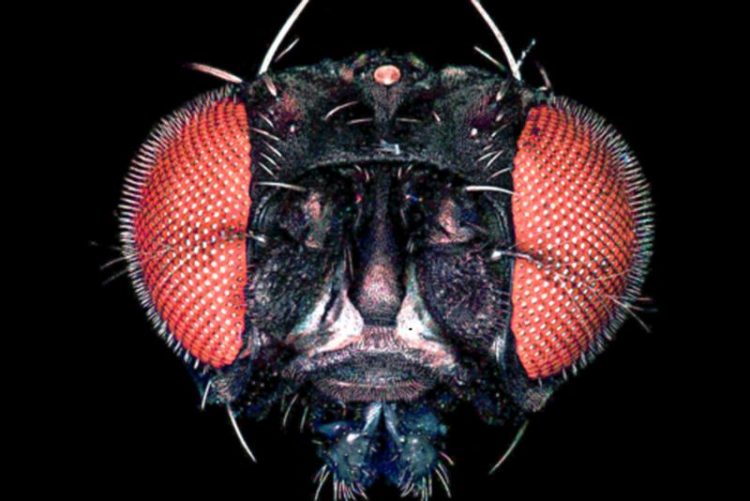Color processing in the tiny brain of fruit flies

Source: Dierk Reiff/Universität Freiburg
Human beings and many animals can distinguish between countless shades of color. But what is the neuronal basis of color vision? How does the brain recognize and perceive color? Both the natural sciences and philosophy have long been interested in these questions.
The working group under the Freiburg biology professor Dierk Reiff and his associate Dr. Christopher Schnaitmann provide new insights into the underlying neuronal mechanisms in the brain of an invertebrate: the team investigated the early stages of color processing in the visual system of the fruit fly Drosophila melanogaster.
The scientists describe a mechanism previously unknown in insects and reached a surprising conclusion: although the visual system of insects and of vertebrates – including humans – differ greatly in structure and molecular nature, qualitatively similar principles of information processing take effect at the exact same position in the neural circuit. The scientists recently published their study in the scientific journal Cell.
“Most people find fruit flies annoying, but for us they are the ideal model organism for understanding how a biological system build of cells – i.e., genetic material, fatty acids, sugars, and proteins – processes visual information”, says Reiff.
Superficially, the case seems simple: light is an excellent medium for transmitting information about the environment. For human beings it is quite natural that light sources and objects have colors. But color is not a property of light. It has physical properties such as wavelength, polarization and intensity.
“In contrast, color is the brain’s invention”, the biologist emphasizes. The photoreceptors of the retina convert changes in light intensity into electrical signals. “At the same time, photoreceptors are color-blind ‘quantum detectors’. While they can efficiently detect photons at a particular wavelength, for instance, they cannot distinguish them from a larger number of photons in a different wavelength range.”
So how does the brain obtain information about the spectral composition of a visual stimulus? The team, together with Dr. Oliver Griesbeck from the Max Planck Institute for Neurobiology in Martinsried, introduced a newly developed tiny protein biosensor into nerve cells of the fruit fly. Combined with an innovative experimental and physiological recording technique, the researchers have gained novel insights into the function of the peripheral visual system, especially photoreceptors.
The scientists used genetic methods to visualize selected features of nerve cells in certain cell types, turn them off and restore them as needed. Unlike what had been assumed previously, the team showed that so-called color opponent processing mechanisms are already detectable in presynaptic terminals of the fruit flies’ photoreceptors. By this mechanism, the brain performs a seemingly simple arithmetic operation required for color vision: it compares the signals of photoreceptors that differ in spectral sensitivity.
A comparison of the discovered neuronal circuit mechanisms and biophysical foundations with the findings from visual research on vertebrates – including humans – shows that the first processing steps in the visual systems of these only very distantly related animals lead to qualitatively similar results at the exact same location in the neuronal circuit. However, the molecules, proteins and cellular mechanisms involved in color opponent processing are fundamentally different in flies and vertebrates.
“Put simply, you could say that the hardware is different, but throughout the course of more than 500 million years the software triumphed, leading to the same results”, explains Reiff. This suggests that different visual systems develop same solutions for same problems, and that the neuronal mechanisms of color vision have evolved independently in both taxa.
The study results help scientists to better understand the fundamental principles and mechanisms underlying information processing in the brain. In the mid-term the research could also contribute to the development of sustainable methods in pest control in for instance agriculture.
Original publication:
Christopher Schnaitmann, Väinö Haikala, Eva Abraham, Vitus Oberhauser, Thomas Thestrup, Oliver Griesbeck, Dierk F. Reiff: Color Processing in the Early Visual System of Drosophila. In: Cell (2018), https://doi.org/10.1016/j.cell.2017.12.018
More about Dierk Reiff’s research:
www.bio1.uni-freiburg.de/tierphys-en/reiff-lab/reiff-lab-en?set_language=en
Contact:
Prof. Dr. Dierk Reiff
Institute of Biology I (Zoology)
University of Freiburg
Tel.: +49 (0)761/203-2576
E-Mail: dierk.reiff@biologie.uni-freiburg.de
https://www.pr.uni-freiburg.de/pm-en/press-releases-2018/color-processing-in-the…
Media Contact
All latest news from the category: Life Sciences and Chemistry
Articles and reports from the Life Sciences and chemistry area deal with applied and basic research into modern biology, chemistry and human medicine.
Valuable information can be found on a range of life sciences fields including bacteriology, biochemistry, bionics, bioinformatics, biophysics, biotechnology, genetics, geobotany, human biology, marine biology, microbiology, molecular biology, cellular biology, zoology, bioinorganic chemistry, microchemistry and environmental chemistry.
Newest articles

New organoid with all key pancreas cells
Researchers from the Organoid group (previously Clevers group) at the Hubrecht Institute have developed a new organoid that mimics the human fetal pancreas, offering a clearer view of its early development….

Unlocking the potential of nickel
New study reveals how to use single atoms to turn CO2 into valuable chemical resources. Nickel and nitrogen co-doped carbon (Ni-N-C) catalysts have shown exceptional performance in converting CO2 into…

‘Spooky action’ at a very short distance
Scientists map out quantum entanglement in protons. Particles streaming from collisions offer insight into dynamic interactions and collective behavior of quarks and gluons. Scientists at the U.S. Department of Energy’s…



